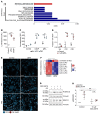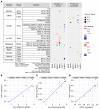Targeting a Braf/Mapk pathway rescues podocyte lipid peroxidation in CoQ-deficiency kidney disease
- PMID: 33444290
- PMCID: PMC7919729
- DOI: 10.1172/JCI141380
Targeting a Braf/Mapk pathway rescues podocyte lipid peroxidation in CoQ-deficiency kidney disease
Abstract
Mutations affecting mitochondrial coenzyme Q (CoQ) biosynthesis lead to kidney failure due to selective loss of podocytes, essential cells of the kidney filter. Curiously, neighboring tubular epithelial cells are spared early in disease despite higher mitochondrial content. We sought to illuminate noncanonical, cell-specific roles for CoQ, independently of the electron transport chain (ETC). Here, we demonstrate that CoQ depletion caused by Pdss2 enzyme deficiency in podocytes results in perturbations in polyunsaturated fatty acid (PUFA) metabolism and the Braf/Mapk pathway rather than ETC dysfunction. Single-nucleus RNA-Seq from kidneys of Pdss2kd/kd mice with nephrotic syndrome and global CoQ deficiency identified a podocyte-specific perturbation of the Braf/Mapk pathway. Treatment with GDC-0879, a Braf/Mapk-targeting compound, ameliorated kidney disease in Pdss2kd/kd mice. Mechanistic studies in Pdss2-depleted podocytes revealed a previously unknown perturbation in PUFA metabolism that was confirmed in vivo. Gpx4, an enzyme that protects against PUFA-mediated lipid peroxidation, was elevated in disease and restored after GDC-0879 treatment. We demonstrate broader human disease relevance by uncovering patterns of GPX4 and Braf/Mapk pathway gene expression in tissue from patients with kidney diseases. Our studies reveal ETC-independent roles for CoQ in podocytes and point to Braf/Mapk as a candidate pathway for the treatment of kidney diseases.
Keywords: Cell Biology; Chronic kidney disease; Genetic diseases; Mitochondria; Nephrology.
Conflict of interest statement
Figures






Similar articles
-
CoQ10 supplementation rescues nephrotic syndrome through normalization of H2S oxidation pathway.Biochim Biophys Acta Mol Basis Dis. 2018 Nov;1864(11):3708-3722. doi: 10.1016/j.bbadis.2018.09.002. Epub 2018 Sep 6. Biochim Biophys Acta Mol Basis Dis. 2018. PMID: 30251690 Free PMC article.
-
Primary coenzyme Q deficiency in Pdss2 mutant mice causes isolated renal disease.PLoS Genet. 2008 Apr 25;4(4):e1000061. doi: 10.1371/journal.pgen.1000061. PLoS Genet. 2008. PMID: 18437205 Free PMC article.
-
Coenzyme Q biosynthesis in health and disease.Biochim Biophys Acta. 2016 Aug;1857(8):1079-1085. doi: 10.1016/j.bbabio.2016.03.036. Epub 2016 Apr 7. Biochim Biophys Acta. 2016. PMID: 27060254 Review.
-
Metabolism of the Flavonol Kaempferol in Kidney Cells Liberates the B-ring to Enter Coenzyme Q Biosynthesis.Molecules. 2020 Jun 27;25(13):2955. doi: 10.3390/molecules25132955. Molecules. 2020. PMID: 32605010 Free PMC article.
-
Coenzyme Q10 deficiencies: pathways in yeast and humans.Essays Biochem. 2018 Jul 20;62(3):361-376. doi: 10.1042/EBC20170106. Print 2018 Jul 20. Essays Biochem. 2018. PMID: 29980630 Free PMC article. Review.
Cited by
-
Mechanism of Cordyceps sinensis and its Extracts in the Treatment of Diabetic Kidney Disease: A Review.Front Pharmacol. 2022 May 13;13:881835. doi: 10.3389/fphar.2022.881835. eCollection 2022. Front Pharmacol. 2022. PMID: 35645822 Free PMC article. Review.
-
Therapeutic Potential Targeting Podocyte Mitochondrial Dysfunction in Focal Segmental Glomerulosclerosis.Kidney Dis (Basel). 2023 Mar 28;9(4):254-264. doi: 10.1159/000530344. eCollection 2023 Aug. Kidney Dis (Basel). 2023. PMID: 37900001 Free PMC article. Review.
-
Combination of theoretical analysis and experiments: Exploring the role of PLA2G7 in human cancers, including renal cancer.Heliyon. 2024 Mar 9;10(6):e27906. doi: 10.1016/j.heliyon.2024.e27906. eCollection 2024 Mar 30. Heliyon. 2024. PMID: 38509948 Free PMC article.
-
The interaction between ferroptosis and inflammatory signaling pathways.Cell Death Dis. 2023 Mar 21;14(3):205. doi: 10.1038/s41419-023-05716-0. Cell Death Dis. 2023. PMID: 36944609 Free PMC article. Review.
-
High-resolution Slide-seqV2 spatial transcriptomics enables discovery of disease-specific cell neighborhoods and pathways.iScience. 2022 Mar 16;25(4):104097. doi: 10.1016/j.isci.2022.104097. eCollection 2022 Apr 15. iScience. 2022. PMID: 35372810 Free PMC article.
References
Publication types
MeSH terms
Substances
Supplementary concepts
Grants and funding
LinkOut - more resources
Full Text Sources
Other Literature Sources
Medical
Research Materials

